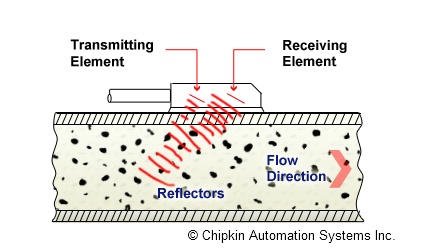Types of Ultrasonic Flowmeters
Ultrasonic flowmeters are categorized into following two types:
Doppler meters: Doppler meters measure the frequency shifts caused by liquid flow. In this, two transducers are mounted in a case attached to one side of the pipe. A signal of known frequency is transmitted into the liquid to be measured. Solids, bubbles, or any other discontinuity in the liquid, cause the signal to be reflected to the receiver element. Since the liquid causing the reflection is moving, the frequency of the returned pulse is shifted. This frequency shift is proportional to the liquid’s velocity or flow rate. A portable Doppler meter which is competent enough of being operated on AC power or from a rechargeable power pack has lately been introduced. A typical Doppler meter using sound pulse reflection principle is shown in the figure below:
Time-of-travel meters: These are also known as Transit meters. They have transducers installed on each side of the pipe. They use the transit time principle for flow measurement. In this, opposite sending and receiving transducers are employed to transmit signals through the flow. The signal travels faster when moving with the flow stream rather than against the flow stream. The difference between the two transit times is used to determine the flow rate.
As per configuration, the sound waves travel between the devices at a 45 degree angle to the fluid flow direction. The speed of the signal traveling between the transducers depends upon (increases or decreases) the direction of transmission and the velocity of the liquid being measured. A time-differential relationship proportional to the flow can be acquired by transmitting the signal alternately in both directions. A major limitation of time-of-travel meters is that the liquids being measured must be moderately free of entrained gas or solids. This is crucial for minimizing signal scattering and absorption.
Advantages
- Ultrasonic meters are made up of no moving parts.
- They experience no pressure loss.
- They endow with maintenance-free operation. It is a key advantage as compared to conventional mechanical meters such as positive displacement meters, turbines etc.
- Furthermore, Ultrasonic flowmeters are consistently more accurate and reliable than a lot of other metering systems.
- With the emergence of 3-beam ultrasonic, all other flowmeters like mass, vortex, positive displacement and turbine flowmeters which are used to measure non-conductive fluids, have been successfully replaced by ultrasonic meters.
Multiple Measurement Channels
Accuracy of single beam measurement is within 2-3%. This range of accuracy is sufficient only for few applications. Nowadays, demand has risen grown for more accurate measurements. This resulted in the introduction of two beam ultrasonic meter technology, which provided an accuracy of 0.5%. However, the instruments still experienced troubles in differentiating between laminar and turbulent flow.
In order to improve accuracy, Krohne introduced the Altosonic V employing five measurement channels i.e. ten sensors which became the first ultrasonic Flowmeter to meet the severe requirements for custody transfer of high value oil products. Another benefit of the multiple measurement channels is redundancy, which allows the meter to function perfectly even if one of the sensors stops working. Five beam meters happens to be too expensive in few applications, because of which Krohne developed 3-beam meters.
3-beam Ultrasonic Flowmeters
Three beam ultrasonic flowmeters are an inexpensive middle-ground solution, employing the knowledge acquired in 5-beam meters to give cost effective accuracy with the advantages of ultrasonic measurement. The latest 3-beam ultrasonic flowmeters are offered in following two versions:
- one version is for the oil and gas industry and
- the another one is for chemicals and other processing applications
Main features of 3- beam ultrasonic meters are given below:
- The third beam enables the instrument to differentiate between laminar and turbulent flow, and to compensate for it with the aid of intelligent software,
- They results in accuracy up to 0.3%.
- The 3-beam meters make use of software using the Digital Signal Processing (DSP) technique to transform analog signals into digital signals. These digital signals can then be processed in abundant ways to make information on the measurement process.
Added advantages presented by 3-beam ultrasonic meters include:
- It has the ability to measure low flow efficiently.
- The most noticeable advantage of DSP in the 3-beam ultrasonic flowmeter is that via intelligent signal processing the 3-beam can now handle attenuations, which results in measurement problems, much better than other ultrasonic flowmeters.
- Three beam ultrasonic flowmeters can now easily meet the accuracy requirements of the petrochemical or chemical industry at lowest possible cost.
- An important advantage over vortex flowmeters is the extended metering range.
- Wide rangeability & bi-directional operation,
- Better sampling spectrum,
- DSP and dedicated software options
Applications
- Ultrasonic flowmeters are perfect for wastewater applications or any other dirty liquid which is conductive or water based.
- Ultrasonic flowmeters normally does not work with distilled water or drinking water. Aerations would be needed in the clean liquid applications.
- Ultrasonic flowmeters are also best suited for applications where low pressure drop, chemical compatibility, and low maintenance are involved.
Sources

Thanks